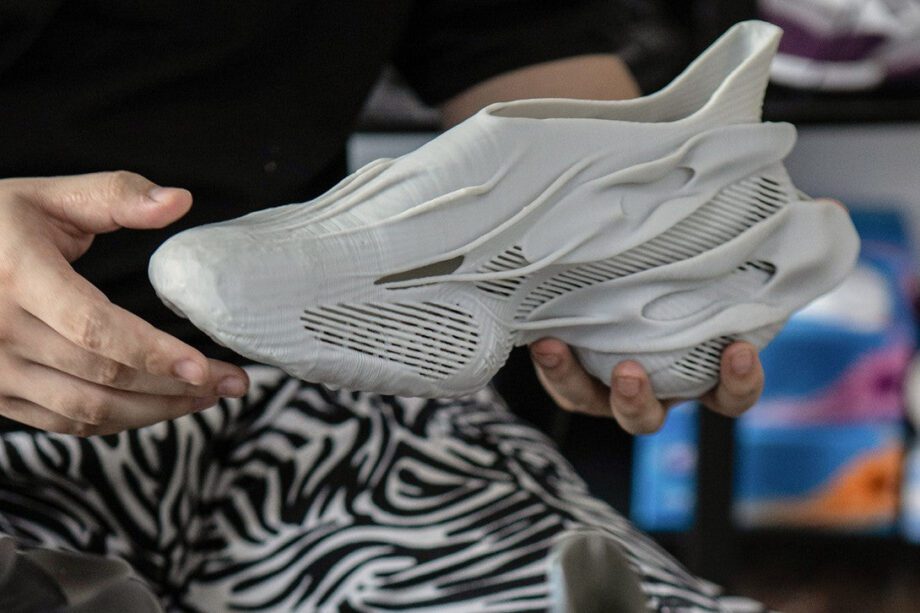For the designer, 3D printing allows for experimentation – and that’s where the fun begins.
3D printing is nothing new, especially in the footwear industry, where it has quickly become a rising market. There’s Zellerfeld, the company that Heron Preston enlisted to develop the HERON01, which is trying to put a printed shoe on every foot in the world, and there is adidas, which kickstarted things with its 3D and 4D sole units back in 2015, since becoming a Three Stripes staple. And then there’s SCRY™ Lab, which takes a slightly different, avant-garde direction.
Headed up by the 22-year-old Zixiong Wei, SCRY™ Lab is an emerging footwear brand based in Beijing. “Competing against others is never the objective,” Wei told HYPEBEAST back in January 2021. Instead, SCRY™ Lab wants to showcase what’s possible in the realms of experimentation – if a prototype doesn’t work, that’s okay because it still did something, it still pushes the boundaries of what could be possible.
However, if the SCRY™ Lab Shuttle – its signature silhouette – does work, what does it mean for the wider industry? In this latest issue of Sole Mates, HYPEBEAST visited SCRY’s Beijing studio to learn more about the 3D process, conceptual design and the “Digital Embryo” philosophy that Wei adheres to, as well as to hear more about Wei’s passion for footwear.
HYPEBEAST: What first attracted you to the sneaker world?
Zixiong Wei: When I was in junior high school, I saw my friend wearing a pair of black and white striped basketball shoes with the Three Stripes on the side. I felt that I didn’t really pay attention to shoes before, but then I started to take the initiative to learn about the design and history of each brand.
I started with sneaker magazines, and then I paid attention to new products, posting about it or going onto Google to look at the historically unpopular shoes of various brands. [Finding them] gave me a treasure-hunting feel.
What was your first pair?
My first pair of sneakers was the Reebok GL6000, a pair of ordinary running shoes. These shoes were bought after I told my father my hobby of shoes for the first time. What’s interesting is that I thought my father wouldn’t about these brands and shoes, but he has a lot more knowledge in retro jogging shoes than me.
I also took a closer look at my father’s shoe cabinet and found a lot of old New Balance shoes in it.
Was there a particular shoe that inspired you to do what you do today?
Nike’s Wind series. The visual impact brought by the integrated and rigid body made me realize the shoe’s originality. It is not only the stitching and cutting of the fabric, but also the holes and the curves, the beauty of it all.
In fact, since high school, I have often thought about how to make a pair of my own shoes, but it was not until college that I realized the challenge of making a new pair of shoes was hard. I know many excellent designers, and they are all capable, but many people can be reduced to conceptual sketchers due to cost and manufacturing issues.
Outside a large company, it is a big challenge and investment to make a new pair of shoes. Even so, I was determined to lower the threshold of shoe design and manufacturing, and established the SCRY brand. SCRY has been exploring different future possibilities, rather than pursuing lighter, faster, and more resilient forward directions in the traditional sense. Sometimes, it is not the internal things that disrupt an industry.
Does the name SCRY have any special meaning, and what does the “Digital Embryo” concept represent?
SCRY is the abbreviation of my Instagram account “scccccry”. The literal translation is “looking into the future through a crystal ball.” I think this is a very interesting point, because the “crystal ball” can be understood as technology that has not yet been understood, and it can also be understood as a future that will not be linearly deduced.
I think SCRY is always exploring different future possibilities, rather than pursuing lighter, faster, and more resilient ones. Sometimes, it is not the internal industry that disrupts an industry.
The concept of “Digital Embryo” is a framework technology that aims to run through the entire design and manufacturing process of a pair of shoes with a fully digital process, all while achieving the 3D printing mass production capacity, thus ensuring scalability of virtual shoes. It can also realize a seamless online and offline business model.
For example, I can produce a lot of virtual simulation concept shoes and let consumers choose and order shoes, and then I will print them. Furthermore, the “Digital Embryo” as the underlying framework can achieve true modular customization. A shoe can have hundreds of combinations.
As soon as your first design – the SCRY Shuttle – was unveiled, it caused a lot of discussion on the Internet.
The Shuttle has a lot of openings and hollows on the front, back, and sides. In fact, about 70% of the drain grooves are designed so that it can be completely printed.
There is a pair of pure transparent samples. This is a sample that was unexpectedly printed. Because the print quality is closely related to the light transmittance of the material, the light transmittance of this version is too high, so this sample is almost two or three times heavier than the normal Shuttle. And finally broke at the tail. Although these test pieces are not really wearable, they are very interesting.
How long does it take to take a shoe from conceptualization to a finished product?
The product development itself takes about two weeks, including brand new shoe styles and design languages. However, the launch of a pair of shoes requires market planning and the formulation of sales plans, so the current cycle of our new pair of shoes is about two months.
In my opinion, a brand vision is equivalent to a platform. In future products, more diversified design styles will be included.
SCRY is building an online design platform to open design rights to the public. If SCRY represents the future, what do you think is the next wave of sneaker design trends?
Free and diversified. Technology will promote the progress and collision of footwear design. In the near future, we will launch an online design platform and open it to the public. I eagerly hope that the culture and ideas of other industries will collide with the footwear industry.
Aside from your brand and focusing more on yourself, which pair of shoes do you wear most often?
The most worn daily is New Balance M1500SG. These British-made 1500 color schemes caught me at first sight, and the British-made shoes really don’t collapse regardless of how they are worn, so I have worn them for the recent daily commuting.
What pair of shoes are you most reluctant to wear?
This pair of New Balance MT580PUG – they’re from 2010 and the midsole is about to start crumbling. Wearing it once more will make this pair of shoes scrapped.
Which pair of shoes are your most expensive?
The most expensive pair should be this pair of Rombaut Embryo Future Leathers. I rarely buy boots. This pair is eye-catching and I often wear it.
And finally, which is your latest pair of shoes?
These latest shoes of mine are also from Rombaut. These Drone Regenerated Nylon slippers are made from the pair of boots above. Most slippers on the market are pretty much the same – these really catch my eye.
This issue of Sole Mates was originally posted on HYPEBEAST ZH and has been adapted accordingly.
SOURCE: https://hypebeast.com/2022/1/scry-lab-3d-printed-shoes-zixiong-wei-sole-mates



















